| The Origin and Nature of the Emotions: Miscellaneous Papers | ||
PHYLOGENETIC ASSOCIATION IN RELATION TO THE EMOTIONS[1]
The surgeon is familiar with the manifestations of every variety of the human emotions in the various stations of life, from infancy to senility, in health and in disease. Not only does he come into intimate contact with the emotions displayed by the victims of disease and of accidents, but he also observes those manifested by the relatives and friends of the families of his patients. Moreover, he is unhappily forced to notice the emotional effect upon himself when he is waging an unequal battle against death—the strain and worry at a crisis, when a life is in the balance and a single false move may be fatal, is an experience known only to the operating surgeon.
For the data for this paper, therefore, in which I shall for the most part limit my discussion to the strongest of all emotions—fear—I have drawn largely from my personal experience as a surgeon, as well as from an experimental research in which I have had the valuable assistance of my associates, Dr. H. G. Sloan, Dr. J. B. Austin, and Dr. M. L. Menten.
I believe it can be shown that it is possible to elicit the emotion of fear only in those animals that utilize a motor mechanism in defense against danger or in escape from it. For example, the defense of the skunk is a diabolic odor which repels its enemies; the skunk has no adequate equipment
What are the principal phenomena of fear? They are palpitation of the heart, acceleration of the rate and alteration of the rhythm of the respiration, cold sweat, rise in body temperature, tremor, pallor, erection of the hair, suspension of the principal functions of digestion, muscular relaxation, and staring of the eyes (Fig. 12). The functions of the brain are wholly suspended except those which relate to the self-protective response against the feared object. Neither the brain nor any other organ of the body can respond to any other lesser stimulus during the dominance of fear.
From these premises it would appear that under the influence of fear, most, perhaps all, of the organs of the body are divided sharply into two classes: First, those that are stimulated, and, second, those that are inhibited. Those that are stimulated are the entire muscular system, the vasomotor and locomotor systems, the senses of perception, the respiration, the mechanism for erecting the hair, the
Are any other organs stimulated by fear except those that can or that do assist in making a defensive struggle? I know of none. On the other hand, if an animal could dispense with his bulky digestive organs, whose functions are suspended
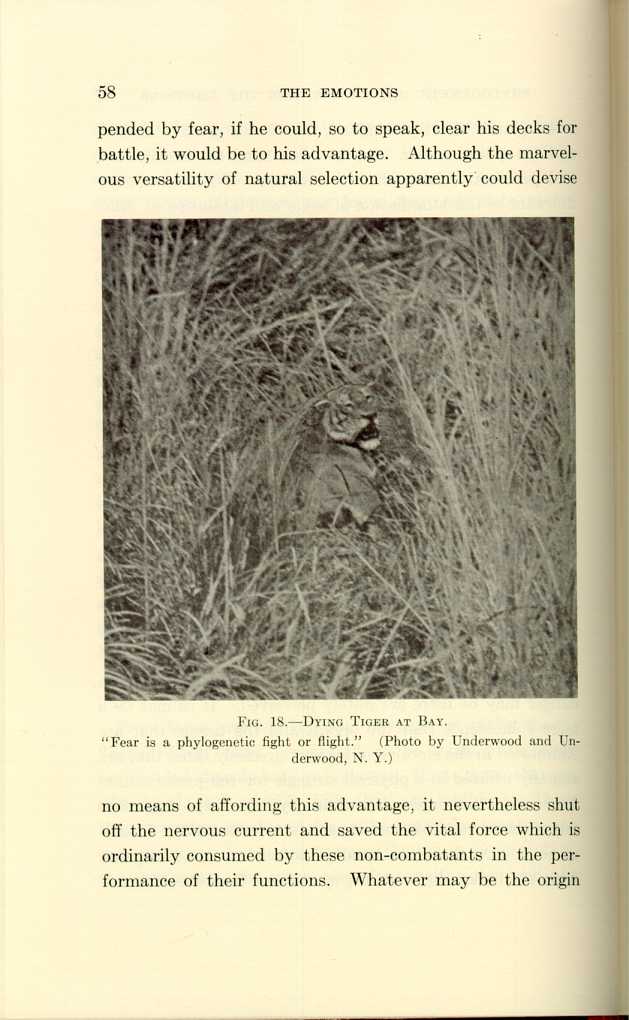
FIG. 18.—DYING TIGER AT BAY.
"Fear is a phylogenetic fight or flight." (Photo by Underwood and
Underwood, N. Y.)
[Description: Black-and-white photograph of a tiger lying down in tall grass.]
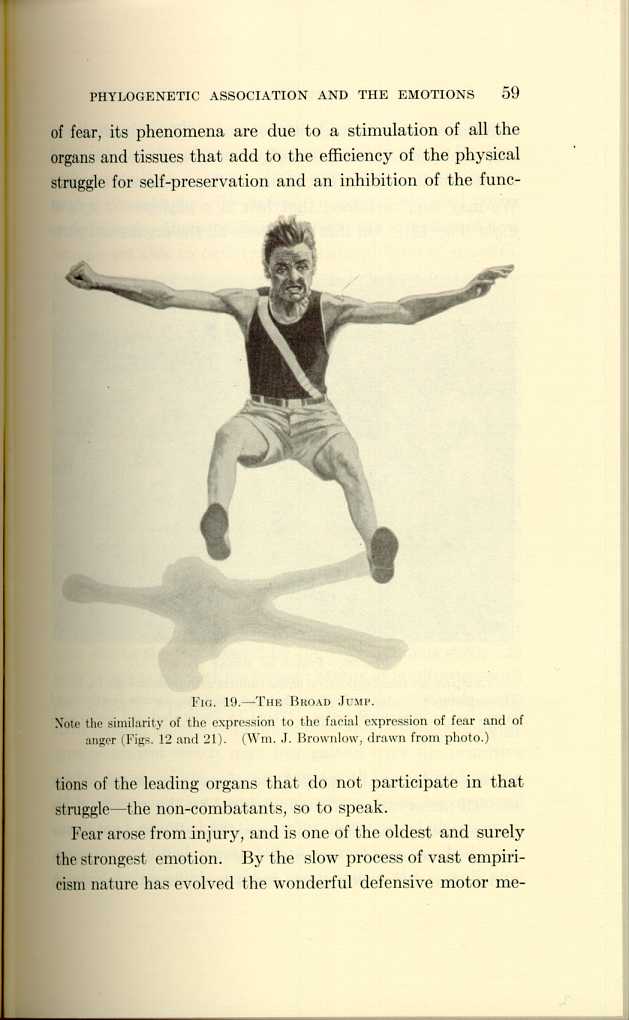
FIG. 19—THE BROAD JUMP.
Note the similarity of the expression to the facial expression of fear and of
anger (Figs. 12 and 21). (Wm. J. Brownlow, drawn from photo.)
[Description: Black-and-white illustration of man mid-jump, performing the broad
jump.]
Fear arose from injury, and is one of the oldest and surely the strongest emotion. By the slow process of vast empiricism nature has evolved the wonderful defensive motor mechanism
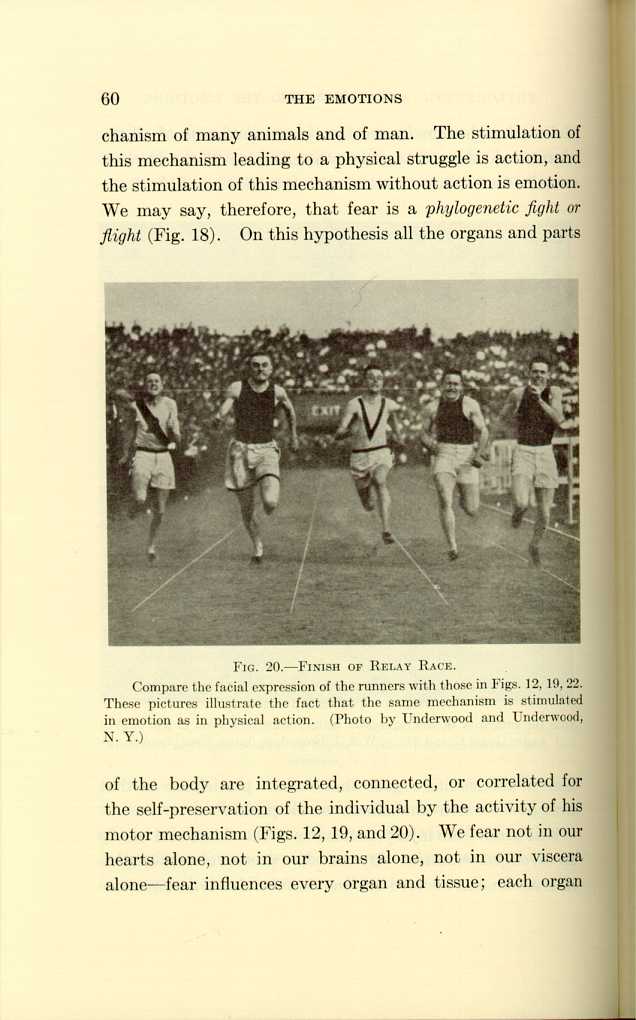
FIG. 20.—FINISH OF RELAY RACE.
Compare the facial expression of the runners with those in Figs. 12, 19, 22.
These pictures illustrate the fact that the same mechanism is stimulated
in emotion as in physical action. (Photo by Underwood and Underwood,
N. Y.)
[Description: Black-and-white photograph of five men nearing finish line of a
foot race.]
When this conception is applied to the human beings of today, certain mysterious phenomena are at once elucidated. It must be borne in mind that man has not been presented with any new organs to meet the requirements of his present state of civilization; indeed, not only does he possess organs of the same type as those of his savage fellows, but of the same type also as those possessed by the lower animals even. In fact, man has reached his present status of civilization with the primary equipment of brutish organs. Perhaps the most striking difference between man and animals lies in the greater control which man has gained over his primitive instinctive reactions. As compared with the entire duration of organic evolution, man came down from his arboreal abode and assumed his new rôle of increased domination over the physical world but a moment ago. And now, though sitting at his desk in command of the complicated
If the stimulus of fear be repeated from day to day, whether in the case of a mother anxious on account of the illness of a child; a business man struggling against failure; a politician under contest for appointment; a broker in the daily hazard of his fortune; litigants in legal battle, or a jealous lover who fears a rival; the countless real as well as the baseless fears in daily life, in fact, all forms of fear, as it seems to me, express themselves in like terms of ancestral physical contests. On this law, fear dominates the various organs and parts of the body.
Anger and fear express opposite emotional states. Fear
is the expression of a strong desire to escape from danger;
anger, of a strong desire to attack physically and to vanquish
opposition. This hypothesis is strongly supported by the
outward expressions of fear and of anger. When the business
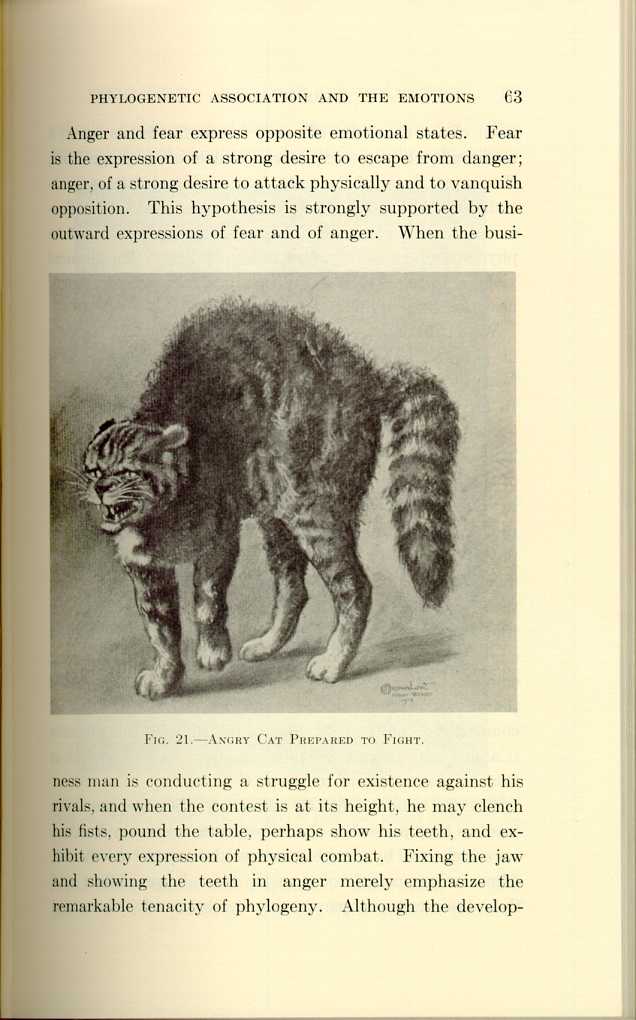
FIG. 21.—ANGRY CAT PREPARED TO FIGHT.
[Description: Black-and-white illustration of cat with bowed back, bristling
fur, teeth bared.]
We have now presented some of the reasons based largely on gross animal behavior why fear is to be regarded as a response to phylogenetic association with physical danger. In further support of this hypothesis, I shall now present some clinical and experimental evidence. Although there is not convincing proof, yet there is evidence that the effect of the stimulus of fear upon the body when unaccompanied by physical activity is more injurious than is an actual physical contest which results in fatigue without gross physical injury. It is well known that the soldier who, while under fire, waits in vain for orders to charge, suffers more than the soldier who flings himself into the fray; and that a wild animal endeavoring to avoid capture suffers less than one cowering in captivity. An unexpressed smouldering emotion is measurably relieved by action. It is probable that the various energizing substances needed in physical combat, such as the secretions of the thyroid, the adrenals (Cannon), etc., may cause physical injury to the body when they are not consumed by action (Fig. 22).
That the brain is definitely influenced—damaged even—by fear has been proved by the following experiments: Rabbits were frightened by a dog but were neither injured nor chased. After various periods of time the animals were killed and their brain-cells compared with the brain-cells of normal
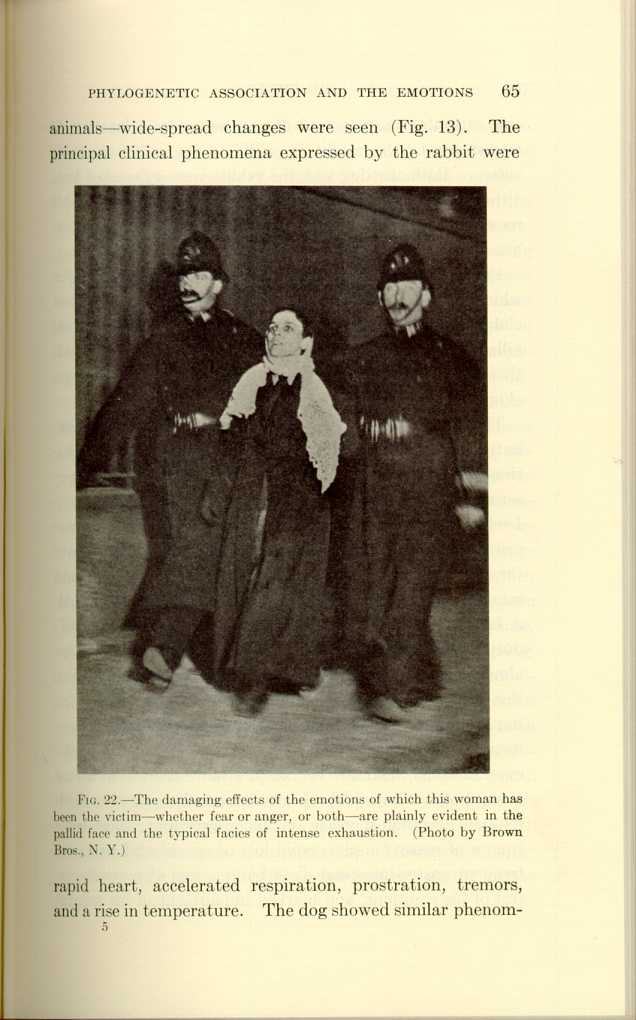
FIG. 22.—The damaging effects of the emotions of which this woman has been the victim—whether fear or anger, or both—are plainly evident in the pallid face and the typical facies of intense exhaustion. (Photo by Brown Bros., N. Y.)
[Description: Black-and-white photograph of woman being escorted by two policemen.]Further observations were made upon the brain of a fox which had been chased for two hours by members of a hunt club, and had been finally overtaken by the hounds and killed. Most of the brain-cells of this fox, as compared with those of a normal fox, showed extensive physical changes (Fig. 4).
The next line of evidence is offered with some reservation, but it has seemed to me to be more than mere idle speculation. It relates to the phenomena of one of the most interesting diseases in the entire category of human ailments—I refer to exophthalmic goiter, or Graves' disease, a disease primarily involving the emotions. This disease is frequently the direct sequence of severe mental shock or of a long and intensely worrying strain. The following case is typical: A broker was in his usual health up to the panic of 1907; during this panic his fortune and that of others were for almost a year in jeopardy, failure finally occurring. During this heavy strain he became increasingly nervous and by imperceptible degrees there developed a pulsating enlargement of the thyroid gland, an increased prominence of the eyes, marked increase in perspiration—profuse sweating even—palpitation of the heart, increased respiration with frequent sighing, increase in blood-pressure; there were tremor of many muscles, rapid loss of weight and strength, frequent gastro-intestinal disturbances, loss of normal control of his emotions, and marked impairment of his mental
In young women exophthalmic goiter often follows in the wake of a disappointment in love; in women, too, it frequently follows the illnesses of children or parents during which they have had to endure the double strain of worry and of constant care. Since such strains usually fall most heavily upon women, they are the most frequent victims of this disease. Now, whatever the exciting cause of exophthalmic goiter, whether it be unusual business worry, disappointment in love, a tragedy, or the illness of a loved one, the symptoms are alike and closely resemble the phenomena of one of the great primitive emotions. How could disappointment in love play a rôle in the causation of Graves' disease? If the hypothesis which has been presented as an explanation of the genesis and the phenomena of fear be correct, then that hypothesis explains also the emotion of love. If fear be a phylogenetic physical defense or escape which does not result in muscular action, then love is a phylogenetic conjugation without physical action. The quickened pulse, the leaping heart, the accelerated respiration, the sighing, the glowing eye, the crimson cheek, and many other phenomena are merely phylogenetic recapitulations of ancestral acts. The thyroid gland is believed to participate in such physical activities. Hence it may well follow that the disappointed maiden who is intensely integrated for a youth will, at every thought of him, be subjected by phylogenetic association to a specific stimulation analogous to that which attended the ancestral consummation. Moreover, a happy marriage has many times been followed by a cure of the
The victims of Graves' disease present a counterpart of emotional exhaustion. That the emotions in Graves' disease are abnormally acute is illustrated by my personal observation of the death of a subject of this disease from fear alone. Whatever the exciting cause of this disease, the symptoms are the same; just as in fear, the phenomena are the same whatever the exciting cause.
Figures 12 and 16 show the resemblance between the outward appearances of a patient with Graves' disease and of a person obsessed by fear. Fear and Graves' disease have the following phenomena in common: Increased heart-beat, increased respiration, rising temperature, muscular tremors, protruding eyes, loss in weight; Cannon has found an increased amount of adrenalin in the blood in fear and Frankel in Graves' disease; increased blood-pressure; muscular weakness; digestive disturbances; impaired nervous control; hypersusceptibility to stimuli; in protracted intense fear the brain-cells show marked physical changes, and in Graves' disease analogous changes are seen (Figs. 13 C and 15). In Graves' disease there seems to be a composite picture of an intense expression of the great primitive emotions. If Graves' disease be a disease of the great primitive emotions, or rather of the whole motor mechanism, how is the constant flow of stimulation of this complicated mechanism supplied? It would seem that there must be secreted in excessive amount some substance that activates the motor mechanism. The nervous system in Graves' disease is hypersusceptible to stimuli and to thyroid extract. It might follow that even a normal amount of thyroid secretion
This condition of excessive motor activity and hyper-excitability may endure for years. What is the source of this pathologic excitation? The following facts may give a clue. In suitable cases of Graves' disease, if the thyroid secretion is sufficiently diminished by a removal of a part of the gland or by interrupting the nerve and the blood supply, the phenomena of the disease are diminished immediately, and in favorable cases the patient is restored to approximately the normal condition. The heart action slows, the respiratory rate falls, the restlessness diminishes, digestive disturbances disappear, tremors decrease, there is a rapid increase in the body weight, and the patient gradually resumes his normal state. On the other hand, if for a period of time extract of the thyroid gland is administered to a normal individual in excessive dosage, there will develop nervousness, palpitation of the heart, sweating, loss of weight, slight protrusion of the eyes, indigestion; in short, most of the phenomena of Graves' disease and of the strong emotions will be produced artificially (Figs. 15 and 23). When the administration of the thyroid extract is discontinued, these phenomena may disappear. On the other hand, when there is too little or no thyroid gland, the individual becomes dull, stupid, and emotionless, though he may be irritable; while if a sufficient amount of thyroid extract be given to such a patient he may be brought back to his normal condition.
Hence we see that the phenomena of the emotions may within certain limits be increased, diminished, or abolished
Graves' disease may be increased by giving thyroid extract and by fear. It may be diminished by removing a part of the gland, or by interrupting the blood and nerve supply, or by complete rest. In addition, at some stage of Graves' disease there is an increase in the size and in the number of the secreting cells. These facts regarding the normal and the pathologic supply of thyroid secretion point to this gland as one of the sources of the energizing substance or substances, by means of which the motor phenomena of animals are executed and their emotions expressed.
Anger is similar to fear in origin and, like fear, is an integration and stimulation of the motor mechanism and its accessories. Animals which have no natural weapons for attack experience neither fear nor anger, while the animals which have weapons for attack express anger principally by energizing the muscles used in attack. Although, as has already been stated, the efficiency of the hands of man has largely supplanted the use of the teeth, he still shows his teeth in anger and so gives support to the theory that this emotion is of remote ancestral origin and proves the great persistence of phylogenetic association. On this conception we can understand why it is that a patient consumed by worry—which to me signifies interrupted stimulation, a state of alternation between hope and fear—suffers so many bodily impairments and diseases even. This hypothesis explains the slow dying of animals in captivity. It explains the grave digestive and metabolic disturbances which appear under any nerve strain, especially under the strain of fear,
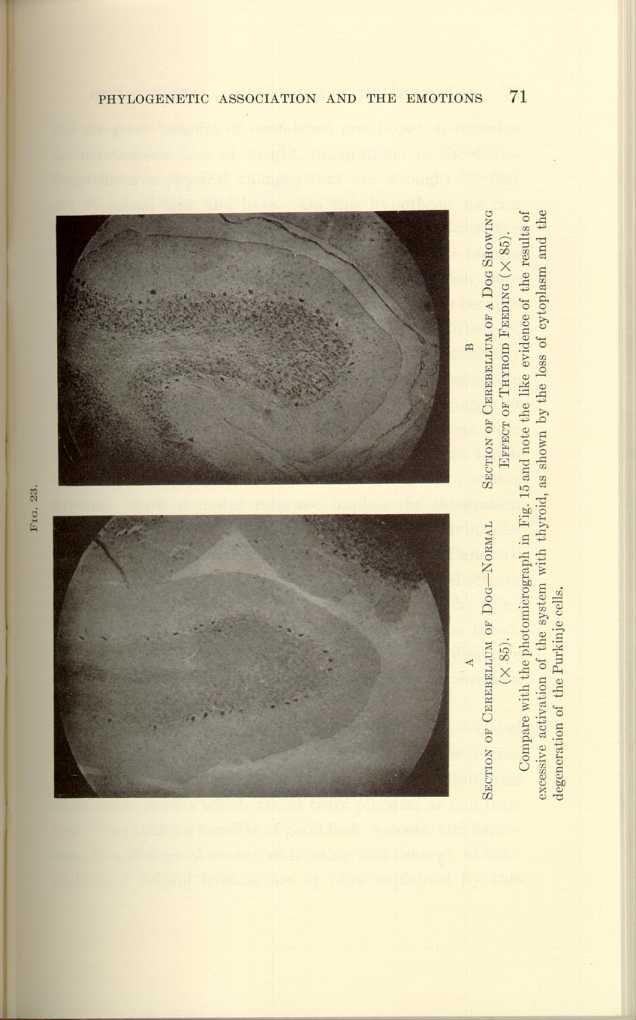
FIG. 23.
A: Section of Cerebellum of Dog—Normal (x85).
B: Section of Cerebellum of a Dog Showing Effect of Thyroid Feeding
(x85).[a]
[Description: Black-and-white photographs showing cerebellum of dog under
various conditions.]
Any agency that can sufficiently inspire faith,—dispel worry,—whether that agency be mystical, human, or divine, will at once stop the body-wide stimulations and inhibitions which cause lesions which are as truly physical as is a fracture. The striking benefits of good luck, success, and happiness; of a change of scene; of hunting and fishing; of optimistic and helpful friends, are at once explained by this
But time will not permit me to follow this tempting lead, which has been introduced for another purpose—the proposal of a remedy.
Worries either are or are not groundless. Of those that have a basis, many are exaggerated. It has occurred to me to utilize as an antidote an appeal to the same great law that originally excited the instinctive involuntary reaction known as fear—the law of self-preservation.
I have found that if an intelligent patient who is suffering from fear can be made to see so plainly as to become firmly convinced that his brain, his various organs, indeed his whole being, could be physically damaged by fear, that this same instinct of self-preservation will, to the extent of his conviction, banish fear. It is hurling a threatened active militant danger, whose injurious influences are both certain and known, against an uncertain, perhaps a fancied, one. In other words, fear itself is an injury which when recognized is instinctively avoided. In a similar manner anger may be softened or banished by an appeal to the stronger self-preserving instinct aroused by the fear of physical damage, such as the physical injury of brain-cells. This playing of one primitive instinct against another is comparable to the effect produced upon two men who are quarreling when a more powerful enemy of both comes threateningly on the scene.
The acute fear of a surgical operation may be banished by the use of certain drugs that depress the associational power of the brain and so minimize the effect of the preparations
The phylogenetic origin of fear is injury, hence injury and fear cause the same phenomena. In their quality and in their phenomena psychic shock and traumatic shock are the same. The perception of danger by the special senses in the sound of the opening gun of a battle, or in the sight of a venomous snake, is phylogenetically the same and causes the same effects upon the entire body as an operation under anesthesia or a physical combat in that each drives the motor mechanism. The use of local anesthetics in the operative field prevents nerve-currents from the seat of injury from reaching the brain and there integrating the entire body for a self-defensive struggle. The result, even though a part of the brain is asleep and the muscles paralyzed, is the same as that produced by the interception of the terrifying sound of the gun, or of the sight of the dangerous reptile, since the stimulation of the motor mechanism is prevented.
By both the positive and the negative evidence we are forced to believe that the emotions are primitive instinctive reactions which represent ancestral acts; and that they therefore utilize the complicated motor mechanism which has been developed by the forces of evolution as that best adapted to fit the individual for his struggle with his environment or for procreation.
The mechanism by which the motor acts are performed and the mechanism by which the emotions are expressed are one and the same. These acts in their infinite complexity
| The Origin and Nature of the Emotions: Miscellaneous Papers | ||